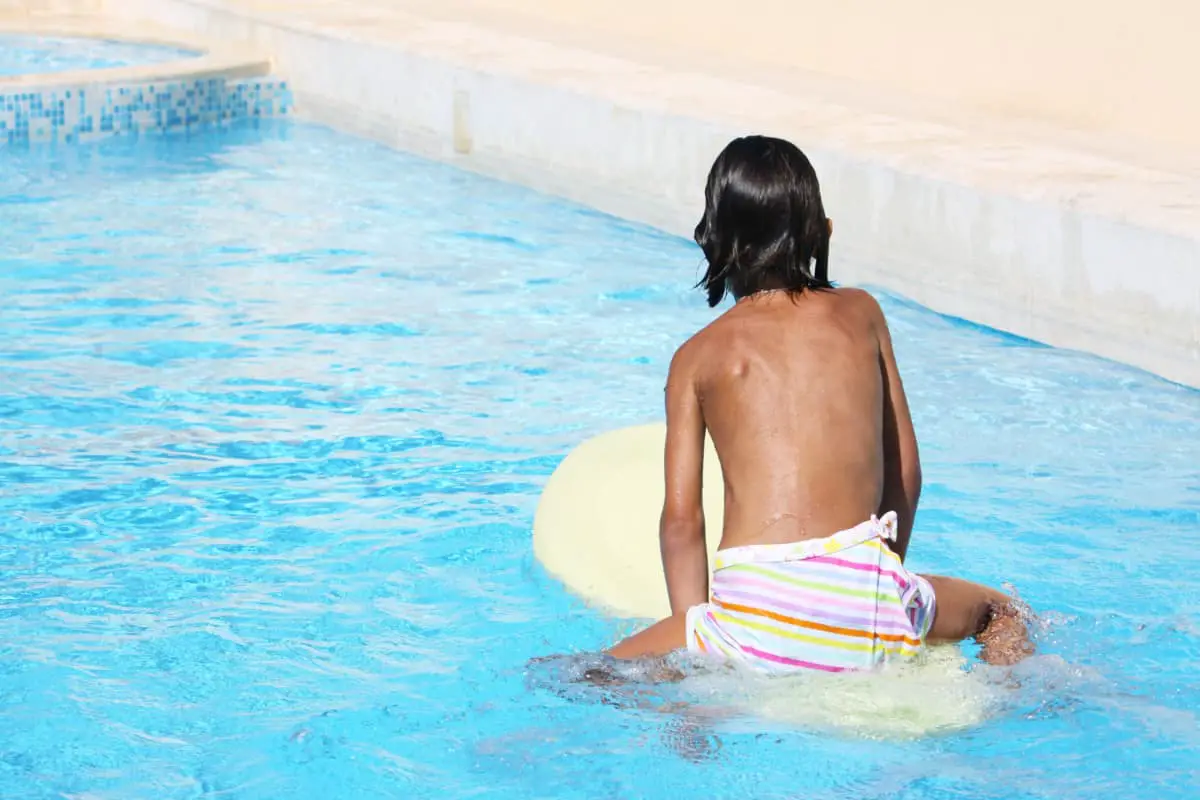Reasonable people know that whenever you want to get better at something, wanting it is not enough. “Practice makes perfect” is a cliche because it’s true, and it applies to everything. But if you’re wanting to get better at surfing and live in a land-locked state, but want to be ready for your summer vacation to the beach, practicing can be tough.
You can practice surfing in a pool, provided that it’s big enough for your surfboard to fit and give you enough clearance to fall off your board. In particular, you can practice laying and balancing on a board, your positioning on the board, paddling, popping up, and duck diving.
Still, there are many things to learn and perfect that don’t involve actual crashing waves, so there are some things you can do in your swimming pool that can help you get better at surfing, and they’ll pay off when you finally put your feet on the sand.
What Kind of Pool?
There are pools, and then there are wave pools. We’re not talking about wave pools here.
Practicing in a regular pool can be great for honing your skills, but we don’t all have access to one of them. If you can get to a wave pool, you can find some tips about learning to surf in one of them from Wave Pool Mag .
.
But there aren’t any waves in your backyard swimming pool or the Olympic-size one in the neighborhood. You can still practice surfing skills in one of them because there’s more to it than just the waves part.
If you’re going to be attempting to pop up or stand on your board, just make sure your pool is large enough so that you don’t injure yourself on the side of your pool if you come off your board.
Learn To Swim in the Pool First
The most obvious thing you can do in a pool is to swim.
If you’ve never surfed before, you need to be a competent swimmer before you ever set foot in the ocean, which is a good rule whether you’re surfing or just throwing a Frisbee for your dog. Knowing how to swim is a must.
Swimming regularly will get you in shape, which is also a must for a surfer.
Popping up onto the board when it’s time to catch that wave isn’t exactly a leisurely activity, and you’ll do a lot of paddling to get out to the waves. Swim laps in your pool to get in some cardio and build endurance and muscle strength.
Your surfing sessions will be better for it.
There’s also a safety aspect to being in good shape. There will be rips that hold you under once in a while, and there will be hard wipe-outs that push you far below the surface. The stamina and breath control you get from swimming regularly will help you come out of these situations safely and quickly.
Things To Practice in the Pool
Maybe your pool session starts with some laps, but when it’s time to move to the board and do some actual in-the-pool surfing practice, there are three skills you’ll want to pay attention to:
- Lying on the board
- Paddling out
- Popping up
Each of these is an essential skill to have, and if you can’t do even one of them well, your surfing time in the ocean will not be fruitful.
Lying on the Board
So much more than getting horizontal on a piece of fiberglass, the way you lie on the board is crucial to everything that happens afterward.
You need to learn where your board’s sweet spot is out of the pool.
This is the balance point over which you’ll want to keep your center of gravity. Lift your board with one hand under it, and your hand is in the sweet spot when the board balances on that one hand.
In the pool, lie on the board over the sweet spot. You’ll know you’re on the sweet spot when the nose of your board rises out of the water just a bit. Your feet should be perpendicular to your legs, and your toes should point down and touch the board just above the end of it.
Arch your back slightly and place your hands near your lower ribs. Don’t grip the rails of the board, but keep your fingers facing forward. Keep your head lifted up and looking straight ahead.
Once you’re comfortable finding the sweet spot and assuming this position, you’re on your way, and you can get there in your pool without ever setting foot in the ocean.
Paddling Out
If you’re in a good-size pool, this will be easier for you.
In a smaller pool, get a friend to hold your board’s leash so you don’t make any forward progress, or maybe even tie the leash down to a fixture around the pool, like the diving board or a ladder or railing.
Lie on your board, head up, back arched, and paddle. The stroke is similar to the freestyle stroke, but you must keep several things in mind here that are not the same:
- Dig deep. Your arms should be straight as they dig down into the water for as long as possible before you bend at the elbow to raise up out of the stroke. Fingers together, too, so that you can get as much forward propulsion as you can.
- Don’t rock from side to side. Swimming freestyle sometimes means a side-to-side rocking motion as your arms wheel through their motions, but that doesn’t work on your board. Pay close attention to your body and board–neither should rock as you paddle. This will take some concentration and repetition to master.
- Keep your head up. It’s tempting to put your head down and paddle harder, but this will interrupt your form, which will only translate into difficulties at other points in your rides. This will help you to help keep your balance, but there are usually other surfers out on the break with you, and you need to be aware of them.
- Stay in the center of the board. Sometimes, in our zeal to paddle harder and faster, we let our bodies slide to the left or right. It doesn’t take a nuclear physicist to realize this will jack up your balance. Always be aware of your body in relation to your board.
Popping Up
The pop-up is the hardest-to-master and most important skill in all of surfing. If you can’t get up on your board, you can’t ride, right?
It’s not hard once you get the hang of it, but it’s hard to learn at first. Here’s what you do (and if you’re planning on surfing in something like Aqua Socks , practice in them):
, practice in them):
- From a lying-down position on your board, push up on your hands and arch your back.
- Swing your front foot (left or right depends entirely on your handedness and what’s comfortable for you) up and plant it between your hands.
- Come to a crouched position–standing but with bent knees.
- Stand all the way up.
That’s it. It’s easy to write, but it’s trickier to do on an actual board, so you’ll need to practice. And Snell Brothers Surfboards put together a thorough video that’s a good beginner’s guide to popping up:
You’re going to fall off either side of your board because the first 30 times you try this in the water, you’re going to shift your center of gravity unacceptably. Don’t get frustrated.
If you are practicing in a pool and can do it every day, you’re going to see improvements, and that’s a fact. So plan your practice sessions: swim for cardio, find the sweet spot, paddle correctly, pop up. Every. Single. Day.
Other Skills
There are things like seated turns and duck dives that you’ll want to learn after you’ve mastered these basics, and there are ways to practice them in the pool. Ki’ili and the gang at iSurfTribe posted this video with some great flat-water ideas for your practice sessions:
Conclusion
While you can’t learn to surf in a pool, you can certainly practice vital skills. If you want to learn to surf, practicing in a pool can be a great way to get ahead of the game before your first dip in saltwater.
If you’re a surfer, practicing these skills and others in a pool is a good habit to have, especially if you can’t hit an actual beach on the reg.
Practice really does make perfect, as any pianist, painter, or plumber will tell you. Surfing is no different. Ocean? Pool? Whatever, man. Just get on your board.

